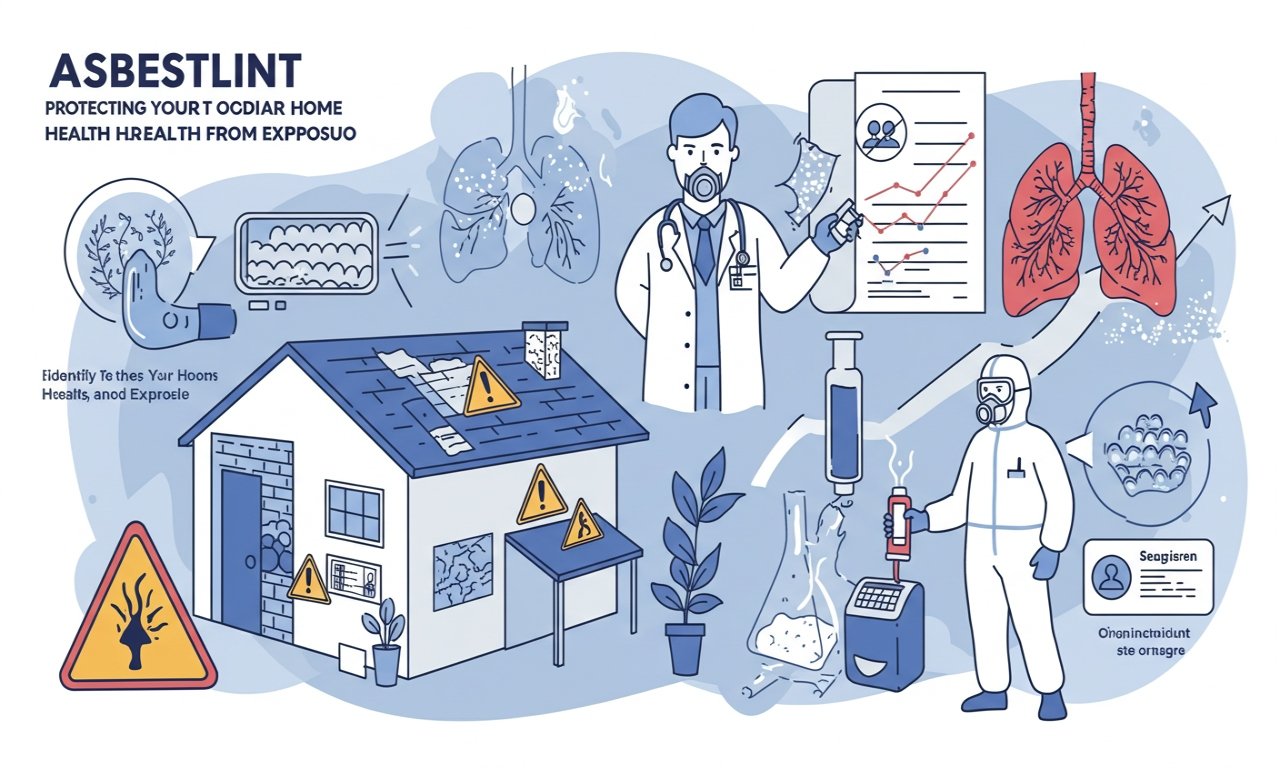Asbestlint, a name that might not ring any bells for many, plays a significant role in various industries. However, its connection to health risks makes it vital to understand. This blog explores the ins and outs of asbestlint—what it is, where it’s used, and how to protect yourself from potential dangers. By increasing awareness about this material, we can take proactive steps toward safeguarding our homes and well-being. Let’s dive into the world of asbestlint and uncover essential insights that could make all the difference for you and your loved ones.
Asbestlint serves as a crucial safety component in various applications, offering significant protection against fire and insulation issues. However, its presence can also pose serious health risks if not managed properly.
You Might Also Like: Aspertaan
Understanding the implications of asbestlint is essential for homeowners and industry professionals alike. Awareness enables us to take necessary precautions that shield our families from potential exposure while ensuring safe environments for work and living spaces.
Understanding Asbestlint and Its Applications
Asbestlint, commonly known for its fire-resistant properties, is a type of asbestos tape. It has been used historically in various construction and industrial applications due to its durability and thermal insulation capabilities.
Industries such as automotive, construction, and shipbuilding utilized asbestlint extensively. However, awareness about the associated health risks has led to increased scrutiny regarding its use in modern applications.
What is Asbestlint?
Asbestlint, or asbestos tape, is a specialized sealing material made from asbestos fibers. It has been widely used for insulation and fireproofing in various construction applications due to its durability and heat-resistant properties.
However, the rising awareness of health risks associated with asbestos exposure has raised concerns. Although effective in its purpose, asbestlint poses serious dangers if not handled correctly. Understanding what it is can help you make informed decisions about safety.
Applications in Different Industries
Asbestlint finds its way into various industries due to its unique properties. It is commonly used in construction, automotive, and aerospace sectors for insulation and fireproofing. This versatility makes it a go-to choice for many applications.
In the manufacturing realm, asbestlint serves as a critical component in products requiring durability. Industries appreciate its resistance to heat and chemicals, but these benefits come with significant health risks that must be managed carefully.
Health Concerns and Risks
Asbestlint poses significant health risks due to its fibrous nature. When disturbed, these fibers can easily become airborne and inhaled, leading to serious respiratory issues.
Long-term exposure may result in diseases such as asbestosis or mesothelioma. Understanding these dangers is crucial for protecting yourself and your loved ones from the hidden threats of this hazardous material in both homes and workplaces.
Health Dangers of Asbestlint Exposure
Asbestlint exposure poses serious health risks. Inhalation of asbestos fibers can lead to severe respiratory issues, including asbestosis and mesothelioma. These conditions arise after prolonged exposure, often unnoticed until significant damage occurs.
Symptoms may take years to develop, making early detection difficult. Individuals living in older homes or working in specific industries are particularly vulnerable. Awareness is crucial for safeguarding your health against this silent threat.
How Asbestlint Affects Health
Asbestlint poses significant health risks due to its fibrous nature. When disturbed, tiny fibers can become airborne and are easily inhaled or ingested. This exposure is linked to serious illnesses like asbestosis and lung cancer.
Long-term contact with asbestlint increases the likelihood of developing mesothelioma, a rare yet aggressive cancer. The cumulative effect of these fibers in the body can lead to severe respiratory issues over time.
Detection and Identification
Detecting asbestlint is crucial for maintaining safety in homes and workplaces. Common sources include older building materials, insulation, and ceiling tiles. If you suspect its presence, professional assessment is essential.
Identification can be tricky without proper tools. Testing kits are available, but hiring certified experts ensures accurate results. They can safely collect samples and analyze them in a lab to confirm the presence of asbestlint without risking exposure.
Common Sources of Asbestlint Exposure
Asbestlint exposure commonly occurs in older buildings, particularly those constructed before the 1980s. Materials like insulation, ceiling tiles, and roofing products often contain this hazardous substance.
Renovation or demolition work raises the risk of disturbing asbestlint. Homeowners should be cautious when handling materials from these sources, especially if they are unsure of their composition. Proper assessment is essential to ensure safety during any home improvement project.
Detecting Asbestlint Safely
Detecting asbestlint safely involves a careful approach. It’s crucial to avoid disturbing materials that may contain asbestos fibers, which can become airborne and pose serious health risks.
Use professional services equipped with the right tools for sampling and analysis. Homeowners should never attempt to remove or handle suspected asbestlint themselves, as improper methods can lead to hazardous exposure. Prioritizing safety is key in detection efforts.
You Might Also Like: Mannacote
Handling and Management
When dealing with asbestlint, safety must be your top priority. Ensure that you wear proper protective gear, including masks and gloves. Avoid disturbing materials containing asbestlint to minimize exposure risk.
If you suspect the presence of asbestlint in your home or workplace, consult a professional for safe removal. They are trained to handle hazardous materials responsibly and can help ensure that all traces are effectively eliminated without endangering anyone’s health.
Legal Ramifications of Asbestlint Exposure
Exposure to asbestlint carries significant legal ramifications. Individuals and companies can face hefty fines if they fail to comply with regulations regarding asbestos handling. Lawsuits often arise when exposure leads to health issues, putting liability on negligent parties.
Building owners are also responsible for maintaining safe environments. If proper safety measures aren’t taken, affected individuals may pursue compensation, creating a complex web of legal challenges that can severely impact reputations and finances.
Managing and Removing Asbestlint Safely
Managing and removing asbestlint requires strict adherence to safety protocols. Always wear appropriate protective gear, such as respirators and disposable coveralls, to minimize exposure risks.
Engage licensed professionals for removal services. They possess the expertise and equipment needed for safe handling. Proper disposal of asbestlint is crucial, ensuring it goes to designated facilities that comply with hazardous waste regulations. This step safeguards both your health and the environment.
Prevention and Awareness
Awareness about asbestlint is vital for everyone. Understanding where it might be found helps in avoiding exposure. Education on the risks associated with asbestlint can empower individuals to make informed choices.
Preventing future exposure requires vigilance. Homeowners should regularly inspect their properties and seek professional help when necessary. By staying proactive, we can create safer environments and protect our health from potential dangers linked to asbestlint.
Importance of Asbestlint Awareness
Awareness of asbestlint is crucial for protecting both health and property. Many people remain unaware of its presence in older buildings or products, leaving them vulnerable to exposure.
Education about the risks associated with asbestlint can empower individuals to take action. By understanding potential hazards, homeowners and workers can implement safety measures and seek professional help when necessary. It’s a vital step towards creating safer environments for everyone.
How to Prevent Future Exposure to Asbestlint
Preventing future exposure to asbestlint begins with awareness. Homeowners should regularly inspect their property, especially in older buildings where asbestlint may be present.
Using professional services for any renovation or demolition work can also significantly reduce risks. Ensure that workers are trained and certified in handling materials that might contain asbestlint safely. Regular maintenance and education about the dangers are key steps toward a safer environment.
Modern Solutions and Alternatives
The shift towards safer building materials is gaining momentum. Modern alternatives to asbestlint include fiberglass, cellulose, and mineral wool insulation. These options provide effective thermal resistance without the health risks associated with asbestos.
Industries are increasingly adopting these innovative solutions for better safety standards. Enhanced regulations promote the use of non-toxic materials, ensuring a healthier environment for workers and homeowners alike. Embracing these changes can lead to improved overall well-being.
Safe Alternatives to Asbestlint
There are several safe alternatives to asbestlint that can provide effective insulation and fire resistance. Materials like fiberglass, mineral wool, and cellulose offer similar benefits without the health risks associated with asbestos.
Additionally, advanced synthetic products have emerged on the market. These options not only enhance safety but also contribute to energy efficiency in homes and buildings while ensuring compliance with modern regulations.
Asbestlint Management in Modern Industry
Asbestlint management is crucial in modern industry. Companies are now required to implement strict protocols for handling and disposing of this hazardous material. Regular training ensures that employees understand the risks associated with asbestlint exposure.
Innovative technologies also play a significant role in monitoring and controlling environments where asbestlint may be present. These advancements help maintain safety standards, reducing the likelihood of exposure for workers and the surrounding community.
You Might Also Like: Doctiplus
Conclusion and Future Outlook
As the understanding of asbestlint evolves, so does our approach to safety. Modern practices focus on minimizing exposure and ensuring healthier environments for everyone.
The future is leaning towards innovative solutions that prioritize human health while maintaining industry standards. With continued awareness and advancements, safer alternatives to asbestlint are becoming increasingly accessible in various sectors, paving the way for a more secure tomorrow.
The Value of Asbestlint in Modern Safety Practices
Asbestlint plays a crucial role in modern safety practices, particularly in construction and renovation. Its durability offers effective insulation while minimizing risks during building processes.
By adhering to strict regulations surrounding asbestlint usage, industries can ensure safer work environments. This not only protects workers but also the general public from potential exposure hazards associated with older materials containing asbestos. Awareness and proper management remain vital for ongoing safety efforts.
Trends Point Toward Safer Alternatives
As the awareness surrounding asbestlint continues to grow, industries are under increasing pressure to adopt safer materials. Innovations in building and insulation technologies have led to effective alternatives that do not compromise safety or performance. These trends reflect a commitment toward protecting both workers and the environment from harmful exposure.
Investments in research and development are paving the way for greener solutions. As more companies prioritize sustainability, the transition away from asbestlint becomes increasingly feasible. This shift signals progress toward a healthier future for all, where safety takes precedence without sacrificing quality or efficiency.

